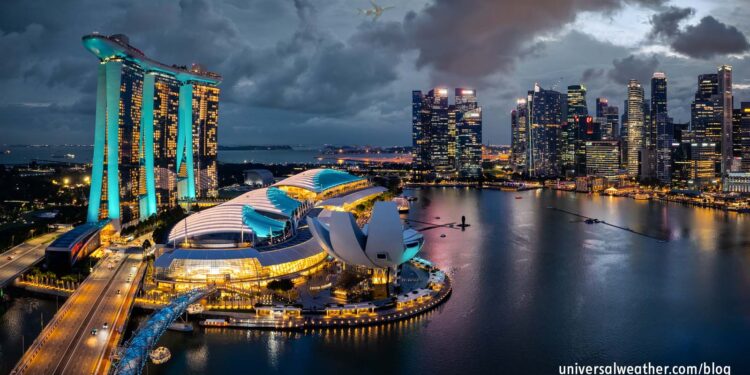Airport Slot Procedures for Singapore

This is a post by author Yvonne Chan. Yvonne is Managing Director for Universal Aviation Singapore, which has an aircraft ground-handling facility in Seletar. Yvonne is an expert on business aircraft operations in Singapore and can be contacted at yvonnechan@universalaviation.aero.
This business aviation blog post is part of a series on operating in Singapore and continues from our last article: “Arranging Aviation Fuel, Security, and Services in Singapore.”
Airport slots are required for operations to Changi (WSSS) but are not needed at this time for Seletar (WSSL). When operating to WSSS, keep in mind that airport slots may only be available outside peak hours of scheduled commercial operations. Here is what you need to know about the airport slot procedure for Singapore:
1. Airport slots are only required for WSSS
It’s best to request airport slots for WSSS as soon as a firm schedule is known. Try to avoid changes, as revised arrival/departure times may not be available. Airport slots are much more difficult to obtain during peak hours of airline operations. If the airport slot requested isn’t available, the slot coordinator will give you the next-best airport slot, which, at times, may be several hours later. All requests are sent via e-mail to the airport slot coordinator that is open 24/7, including holidays. For all airport slot requests, include schedule, registry, operator name, and aircraft type. There is a standard format used to request all airport slots, and that form is supplied by Civil Aviation Authority Singapore (CAAS). Currently, WSSL doesn’t require airport slots, but this may change, depending upon future traffic.
2. Know airport slot application process and suggested lead times
Scheduled commercial carriers are given priority for airport slots, followed by charter operators, and lastly, private flights. Airport slots are required for all arriving and departing aircraft. Preferred minimum lead time for slots is 24 hours, although slots can, at times, be obtained within an hour from the remainder available, which may not be what is requested. Airport slot deviation is -/+ 30 minutes, but the slot coordinator may approve -/+ 60 minutes when an aircraft is en route but delayed.
3. Apply for airport slots outside peak commercial hours of operation
ARRIVAL PEAK HOURS:
0305 TO 0400 UTC (1105 TO 1200 LT) – General Aviation arrivals banned
0805 TO 1000 UTC (1605 TO 1800 LT) – General Aviation arrivals banned
1305 TO 1500 UTC (2105 TO 2300 LT) – General Aviation arrivals banned
DEPARTURE PEAK HOURS:
2205 TO 0300 UTC (0605 TO 1100 LT) – General Aviation arrivals banned
1205 TO 1400 UTC (2005 TO 2200 LT) – General Aviation arrivals banned
Peak hours of operation are in effect seven days a week. There’s usually no exception to general aviation airport slot restrictions during peak hours.
4. Understand the airport slot approval process
Two agencies, the slot coordinator and apron parking authority, are involved in the airport slot process. Once an airport slot request has been e-mailed to the slot coordinator, your ground handler will follow up by phone to confirm the airport slot if they have not received acknowledgment from the slot coordinator within an hour. Airport landing charges are based on size and maximum takeoff weight of the aircraft. These charges must be paid immediately, which is usually done by the ground handler, assuming credit arrangements with the operator have been made. Airport slot revisions are not difficult to obtain so long as there’s still airport slot availability remaining.
5. Follow correct airport slot procedures on the day of operation
Airport slots must be confirmed before any operation to or from WSSS. Your ground handler will coordinate on the day before or the day of operations, with the apron parking department to advise airport slot approvals and secure aircraft parking. Operators should try to keep to allocated airport slot times to avoid delays on departure. For tech stops, it’s always best to arrive and depart outside of peak hours at WSSS.
6. Aircraft will not be repositioned on the airfield without crew notification
If the stay is more than 24 hours, your aircraft may be moved to a remote parking area if short-term parking is full. While crew doesn’t need to be present when the aircraft is repositioned, they must be notified. Best practice is to park aircraft with brakes off.
Conclusion
Operations to Singapore are typically a straightforward and stress-free experience in terms of airport slot arrangements and revisions. However, it’s best practice to call and confirm that your airport slot request has been received in the event you’ve not had an acknowledgement from the slot coordinator.
Questions?
If you have any questions about this article, contact me at yvonnechan@universalaviation.aero.
Later we’ll discuss permit and PPR considerations for Singapore.




